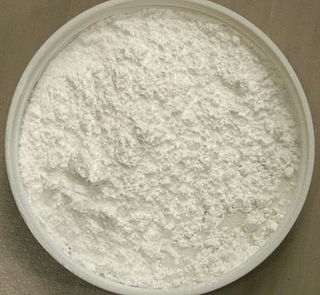Related Research Articles

Superparamagnetism is a form of magnetism which appears in small ferromagnetic or ferrimagnetic nanoparticles. In sufficiently small nanoparticles, magnetization can randomly flip direction under the influence of temperature. The typical time between two flips is called the Néel relaxation time. In the absence of an external magnetic field, when the time used to measure the magnetization of the nanoparticles is much longer than the Néel relaxation time, their magnetization appears to be in average zero; they are said to be in the superparamagnetic state. In this state, an external magnetic field is able to magnetize the nanoparticles, similarly to a paramagnet. However, their magnetic susceptibility is much larger than that of paramagnets.

Magnetite is a mineral and one of the main iron ores, with the chemical formula Fe2+Fe3+2O4. It is one of the oxides of iron, and is ferrimagnetic; it is attracted to a magnet and can be magnetized to become a permanent magnet itself. With the exception of extremely rare native iron deposits, it is the most magnetic of all the naturally occurring minerals on Earth. Naturally magnetized pieces of magnetite, called lodestone, will attract small pieces of iron, which is how ancient peoples first discovered the property of magnetism.

Ferrofluid is a liquid that is attracted to the poles of a magnet. It is a colloidal liquid made of nanoscale ferromagnetic or ferrimagnetic particles suspended in a carrier fluid. Each magnetic particle is thoroughly coated with a surfactant to inhibit clumping. Large ferromagnetic particles can be ripped out of the homogeneous colloidal mixture, forming a separate clump of magnetic dust when exposed to strong magnetic fields. The magnetic attraction of tiny nanoparticles is weak enough that the surfactant's Van der Waals force is sufficient to prevent magnetic clumping or agglomeration. Ferrofluids usually do not retain magnetization in the absence of an externally applied field and thus are often classified as "superparamagnets" rather than ferromagnets.

A nanoparticle or ultrafine particle is usually defined as a particle of matter that is between 1 and 100 nanometres (nm) in diameter. The term is sometimes used for larger particles, up to 500 nm, or fibers and tubes that are less than 100 nm in only two directions. At the lowest range, metal particles smaller than 1 nm are usually called atom clusters instead.

Iron(II,III) oxide, or black iron oxide, is the chemical compound with formula Fe3O4. It occurs in nature as the mineral magnetite. It is one of a number of iron oxides, the others being iron(II) oxide (FeO), which is rare, and iron(III) oxide (Fe2O3) which also occurs naturally as the mineral hematite. It contains both Fe2+ and Fe3+ ions and is sometimes formulated as FeO ∙ Fe2O3. This iron oxide is encountered in the laboratory as a black powder. It exhibits permanent magnetism and is ferrimagnetic, but is sometimes incorrectly described as ferromagnetic. Its most extensive use is as a black pigment (see: Mars Black). For this purpose, it is synthesized rather than being extracted from the naturally occurring mineral as the particle size and shape can be varied by the method of production.

Gadolinium(III) oxide (archaically gadolinia) is an inorganic compound with the formula Gd2O3. It is one of the most commonly available forms of the rare-earth element gadolinium, derivatives of which are potential contrast agents for magnetic resonance imaging.
Magnetofection is a transfection method that uses magnetic fields to concentrate particles containing vectors to target cells in the body. Magnetofection has been adapted to a variety of vectors, including nucleic acids, non-viral transfection systems, and viruses. This method offers advantages such as high transfection efficiency and biocompatibility which are balanced with limitations.
MRI contrast agents are contrast agents used to improve the visibility of internal body structures in magnetic resonance imaging (MRI). The most commonly used compounds for contrast enhancement are gadolinium-based contrast agents (GBCAs). Such MRI contrast agents shorten the relaxation times of nuclei within body tissues following oral or intravenous administration.
Magnetic-targeted carriers, also known as MTCs or magnetic vehicles, are micro- or nanoparticles that carry an anticancer drug to the target site by using an external magnetic field and field gradient to direct the desired drug. Usually, the complex involves microscopic beads of activated carbon, which bind the anticancer drug. A magnet applied from outside the body then can direct the drug to the tumor site. This can keep a larger dose of the drug at the tumor site for a longer period of time, and help protect healthy tissue from the side effects of chemotherapy.

Janus particles are special types of nanoparticles or microparticles whose surfaces have two or more distinct physical properties. This unique surface of Janus particles allows two different types of chemistry to occur on the same particle. The simplest case of a Janus particle is achieved by dividing the particle into two distinct parts, each of them either made of a different material, or bearing different functional groups. For example, a Janus particle may have one-half of its surface composed of hydrophilic groups and the other half hydrophobic groups, the particles might have two surfaces of different color, fluorescence, or magnetic properties. This gives these particles unique properties related to their asymmetric structure and/or functionalization.
Magnetic Nanorings are a form of magnetic nanoparticles, typically made of iron oxide in the shape of a ring. They have multiple applications in the medical field and computer engineering. In experimental trials, they provide a more localized form of cancer treatment by attacking individual cells instead of a general cancerous region of the body, as well as a clearer image of tumors by improving accuracy of cancer cell identification. They also allow for a more efficient and smaller, MRAM, which helps reduce the size of the technology houses it. Magnetic nanorings can be produced in various compositions, shapes, and sizes by using hematite nanorings as the base structure.
Magnetic nanoparticles are a class of nanoparticle that can be manipulated using magnetic fields. Such particles commonly consist of two components, a magnetic material, often iron, nickel and cobalt, and a chemical component that has functionality. While nanoparticles are smaller than 1 micrometer in diameter, the larger microbeads are 0.5–500 micrometer in diameter. Magnetic nanoparticle clusters that are composed of a number of individual magnetic nanoparticles are known as magnetic nanobeads with a diameter of 50–200 nanometers. Magnetic nanoparticle clusters are a basis for their further magnetic assembly into magnetic nanochains. The magnetic nanoparticles have been the focus of much research recently because they possess attractive properties which could see potential use in catalysis including nanomaterial-based catalysts, biomedicine and tissue specific targeting, magnetically tunable colloidal photonic crystals, microfluidics, magnetic resonance imaging, magnetic particle imaging, data storage, environmental remediation, nanofluids, optical filters, defect sensor, magnetic cooling and cation sensors.
Magnet-assisted transfection is a transfection method which uses magnetic interactions to deliver DNA into target cells. Nucleic acids are associated with magnetic nanoparticles, and magnetic fields drive the nucleic acid-particle complexes into target cells, where the nucleic acids are released.

Iron oxide nanoparticles are iron oxide particles with diameters between about 1 and 100 nanometers. The two main forms are composed of magnetite and its oxidized form maghemite. They have attracted extensive interest due to their superparamagnetic properties and their potential applications in many fields including molecular imaging.
Biomagnetics is a field of biotechnology. It has actively been researched since at least 2004. Although the majority of structures found in living organisms are diamagnetic, the magnetic field itself, as well as magnetic nanoparticles, microstructures and paramagnetic molecules can influence specific physiological functions of organisms under certain conditions. The effect of magnetic fields on biosystems is a topic of research that falls under the biomagnetic umbrella, as well as the construction of magnetic structures or systems that are either biocompatible, biodegradable or biomimetic. Magnetic nanoparticles and magnetic microparticles are known to interact with certain prokaryotes and certain eukaryotes.
Magnetogenetics refers to a biological technique that involves the use of magnetic fields to remotely control cell activity.
Magnetic nanoparticle-based drug delivery is a means in which magnetic particles such as iron oxide nanoparticles are a component of a delivery vehicle for magnetic drug delivery, due to the simplicity with which the particles can be drawn to (external) magnetopuissant targets. Magnetic nanoparticles can impart imaging and controlled release capabilities to drug delivery materials such as micelles, liposomes, and polymers.
Superparamagnetic relaxometry (SPMR) is a technology combining the use of sensitive magnetic sensors and the superparamagnetic properties of magnetite nanoparticles (NP). For NP of a sufficiently small size, on the order of tens of nanometers (nm), the NP exhibit paramagnetic properties, i.e., they have little or no magnetic moment. When they are exposed to a small external magnetic field, on the order of a few millitesla (mT), the NP align with that field and exhibit ferromagnetic properties with large magnetic moments. Following removal of the magnetizing field, the NP slowly become thermalized, decaying with a distinct time constant from the ferromagnetic state back to the paramagnetic state. This time constant depends strongly upon the NP diameter and whether they are unbound or bound to an external surface such as a cell. Measurement of this decaying magnetic field is typically done by superconducting quantum interference detectors (SQUIDs). The magnitude of the field during the decay process determines the magnetic moment of the NPs in the source. A spatial contour map of the field distribution determines the location of the source in three dimensions as well as the magnetic moment.
Magnetoelastic filaments are one-dimensional composite structures that exhibit both magnetic and elastic properties. Interest in these materials tends to focus on the ability to precisely control mechanical events using an external magnetic field. Like piezoelectricity materials, they can be used as actuators, but do not need to be physically connected to a power source. The conformations adopted by magnetoelastic filaments are dictated by the competition between its elastic and magnetic properties.

T2*-weighted imaging is an MRI sequence to quantify observable or effective T2. In this sequence, hemorrhages and hemosiderin deposits become hypointense.
References
- ↑ Weizenecker, J.; Gleich, B.; Rahmer, J.; Dahnke, H.; Borgert, J. (2009-01-01). "Three-dimensional real-time in vivo magnetic particle imaging". Physics in Medicine and Biology. 54 (5): L1–L10. Bibcode:2009PMB....54L...1W. doi:10.1088/0031-9155/54/5/L01. ISSN 0031-9155. PMID 19204385. S2CID 2635545.
- ↑ Yu, Elaine Y.; Bishop, Mindy; Zheng, Bo; Ferguson, R. Matthew; Khandhar, Amit P.; Kemp, Scott J.; Krishnan, Kannan M.; Goodwill, Patrick W.; Conolly, Steven M. (2017-03-08). "Magnetic Particle Imaging: A Novel in Vivo Imaging Platform for Cancer Detection". Nano Letters. 17 (3): 1648–1654. Bibcode:2017NanoL..17.1648Y. doi:10.1021/acs.nanolett.6b04865. ISSN 1530-6984. PMC 5724561 . PMID 28206771.
- ↑ Zheng, Bo; See, Marc P. von; Yu, Elaine; Gunel, Beliz; Lu, Kuan; Vazin, Tandis; Schaffer, David V.; Goodwill, Patrick W.; Conolly, Steven M. (2016). "Quantitative Magnetic Particle Imaging Monitors the Transplantation, Biodistribution, and Clearance of Stem Cells In Vivo". Theranostics. 6 (3): 291–301. doi:10.7150/thno.13728. PMC 4737718 . PMID 26909106.
- ↑ Zheng, Bo; Vazin, Tandis; Goodwill, Patrick W.; Conway, Anthony; Verma, Aradhana; Saritas, Emine Ulku; Schaffer, David; Conolly, Steven M. (2015-09-11). "Magnetic Particle Imaging tracks the long-term fate of in vivo neural cell implants with high image contrast". Scientific Reports. 5 (1): 14055. Bibcode:2015NatSR...514055Z. doi:10.1038/srep14055. ISSN 2045-2322. PMC 4566119 . PMID 26358296.
- ↑ Herb, Konstantin; Mason, Erica; Mattingly, Eli; Mandeville, Joseph; Mandeville, Emiri; Cooley, Clarissa; Wald, Lawrence (2020). "Functional MPI (fMPI) of hypercapnia in rodent brain with MPI time-series imaging". International Journal on Magnetic Particle Imaging. 6 (2/1). doi:10.18416/IJMPI.2020.2009009.
- 1 2 3 Chandrasekharan, Prashant; Tay, Zhi Wei; Zhou, Xinyi Yedda; Yu, Elaine; Orendorff, Ryan; Hensley, Daniel; Huynh, Quincy; Fung, K. L. Barry; VanHook, Caylin Colson; Goodwill, Patrick; Zheng, Bo (November 2018). "A perspective on a rapid and radiation-free tracer imaging modality, magnetic particle imaging, with promise for clinical translation". The British Journal of Radiology. 91 (1091): 20180326. doi:10.1259/bjr.20180326. ISSN 1748-880X. PMC 6475963 . PMID 29888968.
- 1 2 Keselman, Paul; Yu, Elaine Y.; Zhou, Xinyi Y.; Goodwill, Patrick W.; Chandrasekharan, Prashant; Ferguson, R. Matthew; Khandhar, Amit P.; Kemp, Scott J.; Krishnan, Kannan M.; Zheng, Bo; Conolly, Steven M. (2017-05-07). "Tracking short-term biodistribution and long-term clearance of SPIO tracers in magnetic particle imaging". Physics in Medicine and Biology. 62 (9): 3440–3453. Bibcode:2017PMB....62.3440K. doi:10.1088/1361-6560/aa5f48. ISSN 1361-6560. PMC 5739049 . PMID 28177301.
- ↑ Makela, Ashley V.; Gaudet, Jeffrey M.; Murrell, Donna H.; Mansfield, James R.; Wintermark, Max; Contag, Christopher H. (2021-10-15). "Mind Over Magnets - How Magnetic Particle Imaging is Changing the Way We Think About the Future of Neuroscience". Neuroscience. 474: 100–109. doi:10.1016/j.neuroscience.2020.10.036. ISSN 1873-7544. PMID 33197498. S2CID 226842684.
- 1 2 Talebloo, Nazanin; Gudi, Mithil; Robertson, Neil; Wang, Ping (2020). "Magnetic Particle Imaging: Current Applications in Biomedical Research". Journal of Magnetic Resonance Imaging. 51 (6): 1659–1668. doi:10.1002/jmri.26875. ISSN 1522-2586. PMID 31332868. S2CID 198169801.
- ↑ Goodwill, Patrick (2012). "X-Space MPI: Magnetic Nanoparticles for Safe Medical Imaging". Advanced Materials. 24 (28): 3870–7. Bibcode:2012AdM....24.3870G. doi:10.1002/adma.201200221. hdl: 11693/53587 . PMID 22988557. S2CID 554405.
- 1 2 Billings, Caroline; Langley, Mitchell; Warrington, Gavin; Mashali, Farzin; Johnson, Jacqueline Anne (January 2021). "Magnetic Particle Imaging: Current and Future Applications, Magnetic Nanoparticle Synthesis Methods and Safety Measures". International Journal of Molecular Sciences. 22 (14): 7651. doi: 10.3390/ijms22147651 . PMC 8306580 . PMID 34299271.
- ↑ Pantke, Dennis; Mueller, Florian; Reinartz, Sebastian; Philipps, Jonas; Mohammadali Dadfar, Seyed; Peters, Maximilian; Franke, Jochen; Schrank, Franziska; Kiessling, Fabian; Schulz, Volkmar (2022-05-17). "Frequency-selective signal enhancement by a passive dual coil resonator for magnetic particle imaging". Physics in Medicine & Biology. 67 (11): 115004. Bibcode:2022PMB....67k5004P. doi:10.1088/1361-6560/ac6a9f. ISSN 0031-9155. PMID 35472698. S2CID 248404124.